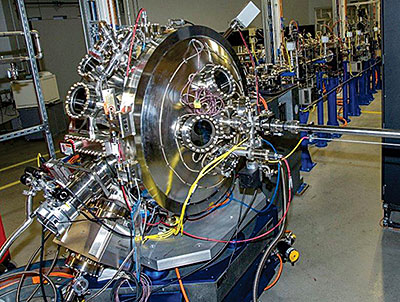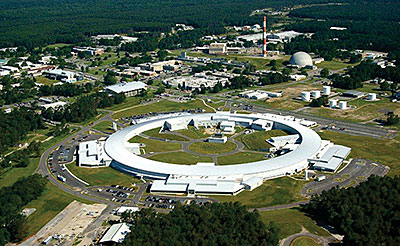Brilliant new x-ray source is up and running at Brookhaven
DOI: 10.1063/PT.3.2648
Although high-temperature superconducting cuprate materials were discovered nearly 30 years ago, scientists have yet to fully understand how they work. Now, with the $912 million National Synchrotron Light Source II (NSLS-II) coming on line at Brookhaven National Laboratory (BNL), researchers will have a new tool that could lead to a more complete theory of the mechanism by which the compounds become superconducting, says John Hill, x-ray group leader in BNL’s condensed-matter physics and materials science group.
“The NSLS-II will be the most advanced synchrotron in the world when in full operation. It will have the most intense beams, will be the most stable, and will have the best instrumentation,” says Steve Dierker, BNL’s associate director for photon sciences. The new machine, under construction since 2009 (see Physics Today,March 2009, page 24
The higher brightness will also increase the experimental throughput and reduce the amount of time required for experiments. Brightness, or brilliance, is photon flux per second per unit bandwidth per unit area per unit solid angle. Intensity is the photon flux per second per unit bandwidth per unit area.
A wide energy spectrum
“We’ve developed new kinds of optics that we’ve demonstrated will focus down to 11 nanometers, and we see no showstoppers to advance that down to the nanometer level,” says Dierker. At such a fine scale, experiments must be shielded from the smallest movements. The NSLS-II was built to dampen the vibrations coming from trucks on the nearby Long Island Expressway and from ocean waves propagating through the sandy soil.
At an energy of 3 GeV, the electrons in the NSLS-II storage ring can efficiently radiate beams that range from the IR to hard x rays of more than 100 keV. “We explicitly chose 3 GeV because we wanted to supply not just hard or soft x rays but to cover the full range,” Dierker says. Other leading light sources aren’t as flexible, he notes. The Advanced Photon Source at Argonne National Laboratory, France’s European Synchrotron Radiation Facility, and Japan’s SPring-8 produce 6- to 8-GeV electrons, which are optimized for hard x rays. The Advanced Light Source at Lawrence Berkeley National Laboratory, on the other hand, is better suited for soft x rays, with its electrons of 1.8 GeV.
Most light-source users, including crystallographers and materials scientists, need x rays with energies of 10–25 keV, a range to which the NSLS-II is well suited, Dierker says.
As of press time, five NSLS-II beamlines had produced their first x-ray beams—an event known as first light. One of those, the Hard X-Ray Nanoprobe, will be used to examine IBM’s newest integrated circuit design, which has feature sizes of 10 nm. “We’ll be able to focus the x-ray beam down to the size of the features and measure the strain that comes from the lattice mismatch between the different materials, and also look at how that affects the electronic properties,” Dierker says. “And we’ll look at how those properties change when we’re pulling a current through it and the device is operating.”
Though difficult enough to measure in one dimension, the IBM samples will need to be moved and measured with nanometer resolution in six dimensions, three positional and three orientational, he notes.
A superconductor puzzle
Hill will be the initial user of the Coherent Soft X-Ray Scattering beamline. His team will look at what happens when they use doping to remove electrons from the copper in the cuprate high-Tc superconductors. The particular arrangement of missing electrons, or holes, determines if cuprates will transition from an insulator to a superconducting state, he says.

The Coherent Soft X-Ray Scattering beamline is the first of 60 to 70 beamlines planned for the National Synchrotron Light Source II. It will have scattering and imaging capabilities and detectors for probing correlated electronic textures and dynamics.
BROOKHAVEN NATIONAL LABORATORY

“At other synchrotrons, when we look at these arrangements of holes, there is a pretty weak signal, and it’s been hard to characterize them well. We hope at NSLS-II, where we have much more intensity, that we will do a much better job of learning where these arrayed patterns occur as a function of temperature and doping,” Hill says.
Ultimately, the NSLS-II will house 60–70 beamlines, says Dierker, though funding is available for only 30 so far. Eight beamlines were budgeted as part of the construction project. Another six, costing $90 million in total, are being financed separately through Department of Energy science programs.

The National Synchrotron Light Source II will be the most brilliant source of synchrotron x rays in the world when it becomes fully operational in 2017.
BROOKHAVEN NATIONAL LABORATORY

An additional five beamlines will be dedicated to the life sciences. The National Institutes of Health has provided $45 million to build three beamlines, plus $5 million per year for their operation. The New York Structural Biology Center, a consortium of nine academic research institutions, is building a beamline, and Case Western Reserve University is building another.
Three beamlines will be built by NIST, which has been a constant partner since the NSLS’s origin 32 years ago. Dan Fischer, a physicist who heads a NIST team of researchers at BNL, says the first of those beamlines will begin operation late this year. It will feature a chemical x-ray photoemission microscope with 10-nanometer resolution and will be capable of probing the structure and chemistry of nanoscale systems such as carbon nanotubes and organic semiconductors.
Several of the instruments to be used on the NIST lines were built and tested at the old NSLS, but they were designed to take advantage of the NSLS-II’s intensity and brightness. One NIST microscope can image areas up to 2 cm2 for spatial and chemical analyses. That’s useful for simultaneously imaging thousands of samples of electronic devices, DNA arrays, and biological materials such as skin, says Fischer. With the new beamlines, NIST researchers will work with about 200 industry, government, and academic partners on characterizing a variety of materials.
The remaining eight beamlines, which will include refurbished components from the NSLS, will be built with operational funds from DOE’s Basic Energy Sciences office. Suited for lower-intensity uses, those lines will provide a cost-effective way to quickly add experimental capacity to the NSLS-II, Dierker says. By fixing up and reusing the components—which include x-ray mirrors; monochromators; end stations (the experimental apparatus for positioning the x-ray beam and sample in a controlled environment and for containing the detectors); and vacuum systems pumps, valves, and controllers—each beamline is costing about $4 million. Purchasing all-new equipment would have cost about $35 million more for all eight beamlines.
Once all 30 beamlines are operating around two years from now, the NSLS-II will host around 2000 researchers per year—about the same number of users as the predecessor ring accommodated, Dierker says. When fully built out with more than 60 beamlines, it will host more than 4000 users annually.
New protein discoveries
As with other DOE light sources, roughly 40% of NSLS users were life scientists. Sean McSweeney, photon science associate division director for structural biology at BNL, says two of the NIH beamlines will be dedicated to protein crystallography. The third will be used for x-ray scattering of noncrystalline materials and will address topics such as proteins in solutions and production of time-resolved images of protein complex formation.
The proteins that are located in cell membranes are key to cell signaling and control the entry and exit of drugs. But membrane proteins don’t form large crystals, so high-resolution measurements of their structures are mostly beyond the range of lower-intensity x-ray sources. The NSLS-II x rays, 10 000 times more brilliant than those of the old NSLS, hold promise for subnanometer-resolution measurements of membrane protein crystals. Determining the composition of those complex molecules is critical to developing targets for new drugs, says McSweeney.
An additional advantage of the NSLS-II’s tightly focused beams will be to minimize the amount of biological materials that are damaged by the x rays, McSweeney adds. The highly automated beamlines will use robotics to move crystals and liquid samples into and out of the beams. The delivery systems and controls for optimizing the beams will be simplified for nonexpert users, he says.
“We’re dealing with flux densities that have not been achieved for crystallography beamlines before, so we’re at the bleeding edge of what is known about how to do experiments. It’s sort of scary,” McSweeney says. Commissioning of the NIH beamlines will begin in about one year, and full operations should be under way in 18 months.
The extensive beamline installations planned for the next two years or so will limit available experimental time on the NSLS-II to 2000–2500 hours per year. After that, 5000 hours a year are anticipated.
Yet to be put into place are all of the computational resources that will be needed to handle the tens of terabytes of data generated during experiments. “In the old days, users would take their data home on a floppy disk, and nowadays on a memory stick, but that’s not going to be possible,” Dierker says. “We’re going to have to develop a different paradigm where the data is collected here, probably stored here, and made accessible to the users.” The concept is for the analysis routines to be hosted on-site so that users can work remotely and archive their data on BNL servers.
The DOE light sources are taking a lesson from the particle-physics community on how to cope with their big-data challenges, he says. Indeed, the NSLS-II is considering partnering with BNL’s Relativistic Heavy Ion Collider program to help manage the problem.
More about the Authors
David Kramer. dkramer@aip.org
